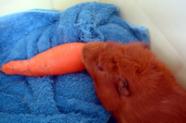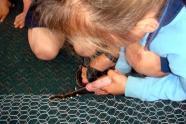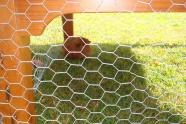Guinea pig hutch
Integrated approach
In a project that successfully integrated technology with mathematics, year 2 students at Murrays Bay School created an outdoor hutch for a guinea pig by recycling a coffee table. This project encouraged the practical applications of measuring tools and calculations within a context of sustainability.
Issue
The stakeholders for this project were a year 5 class at Murrays Bay, whose guinea pig Fuzznut needed a hutch that could be used outdoors during summer time and on fine days.
Specifications
To help find the perfect solution that would meet the needs of the class and Fuzznut, the year 2 students consulted with the older class. This determined that the hutch needed to be easy to move, provide protection from sun, rain and natural predators and still function as an extra work space when Fuzznut was kept inside in winter. The hutch design should feature an open bottom so that Fuzznut could eat the fresh grass underneath while remaining secure, and construction should be within the skill level of the year 2 class and be as cost effective as possible.
Research
To begin their research, the students measured Fuzznut's width and length to ensure that the hutch would be big enough for him to be comfortable and that any holes or gaps would be small enough to keep him enclosed.
Teacher Fleur Knight wanted measurement to play a key role in this unit. "A range of measuring tools were introduced to the students for this unit, including rulers, metre sticks and tape measures for dressmaking and building. The students first tested each of these tools to make sure they were using the right one for each job in the design and construction of the hutch."
Fuzznut's dimensions were then recorded and drawn on a bar graph that was used as a reference point throughout the project.
Design ideas
The students then looked at existing hutch designs, comparing the pros and cons while keeping their specific requirements in mind. The best elements were then incorporated into hutch designs drawn up by the students.
However, a recurring problem came up in all of the student's work: "All of the designs we came up with were too expensive so that's when we decided to investigate recycling as an option."
The class first tested plastic tubs and boxes but found these difficult to incorporate within their design ideas. Eventually an old coffee table was chosen, as it was sturdy and would provide a perfect frame for their designs.
"Guinea pigs chew wood, so we decided not to use a table made from treated timber. But that was not an issue, as the table would not be left outside for prolonged periods of time or in wet weather."
Measurement
The students then measured the range of different nettings available, referring back to their original measurement of Fuzznut to ensure the holes would be small enough to be secure. For size, cost and ease of use, the students chose chicken wire as the best option.
The students then began work on a second set of hutch designs that used a coffee table as the main frame with chicken wire for the walls. The best ideas were then amalgamated into a final design agreed on by the whole class.
Construction
The students measured the coffee table, then used these dimensions to cut lengths of the chicken wire to shape with wire cutters. The netting was then fixed to the coffee table frame with a gun stapler. This prototype had some issues however as the entire table had to be lifted from the ground to remove Fuzznut.
"We tested this design with Fuzznut and found it too hard to catch him, so we decided to make a trap-door in the top of the coffee table. We measured and drew the outline for the trapdoor then got a local builder to come and cut it out for us with a jigsaw."
The students incorporated finger holes in the trap door so that it would be easy to open and close.
"We tested the hutch with Fuzznut again and found that we could get him out easily and that he really liked the size and safety of the hutch."
Outcome
The year 2 students, their year 5 clients, and Fuzznut are all extremely happy with the final outcome. Not only has the hutch solved the initial issue of creating an outdoor habitat for Fuzznut, it can be used as a work surface in class when Fuzznut is being kept inside.



